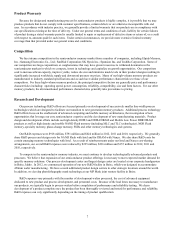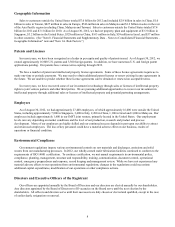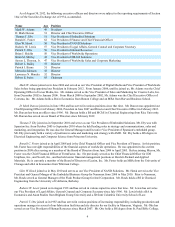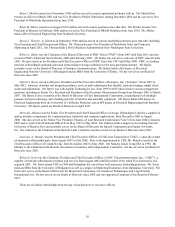Crucial 2012 Annual Report Download - page 17
Download and view the complete annual report
Please find page 17 of the 2012 Crucial annual report below. You can navigate through the pages in the report by either clicking on the pages listed below, or by using the keyword search tool below to find specific information within the annual report.16
Debt obligations could adversely affect our financial condition.
We are engaged in a capital intensive business subject to significant changes in supply and demand and product pricing and
recent periods of consolidation, any of which could result in our incurrence or assumption of indebtedness. In recent periods,
our debt levels have increased and are expected to continue to increase through 2013. As of August 30, 2012, we had $3.3
billion of debt, including $949 million principal amount of convertible senior notes due 2014. In September and October 2012,
we entered into financing arrangements that allow for borrowings up to $469 million. In addition, if we are able to complete
the Elpida acquisition, we will fund 60 billion yen (or approximately $750 million) through a cash payment to Elpida at the
closing, in exchange for 100% ownership of Elpida's equity. The remaining 140 billion yen (or approximately $1.75 billion) of
payments will be made by the Elpida Companies in six annual installments payable at the end of each calendar year beginning
in 2014, with payments of 20 billion yen (or approximately $250 million) in each of 2014 through 2017, and payments of 30
billion yen (or approximately $375 million) in each of 2018 and 2019. We may need to incur additional debt in the future.
Our debt could adversely impact us. For example it could:
• require us to use a large portion of our cash flow to pay principal and interest on debt, including the convertible notes,
which will reduce the availability of our cash flow to fund working capital, capital expenditures, acquisitions, research
and development expenditures and other business activities;
• limit our future ability to raise funds for capital expenditures, strategic acquisitions or business opportunities, research
and development and other general corporate requirements;
• contribute to a future downgrade of our credit rating, which could increase future borrowing costs; and
• increase our vulnerability to adverse economic and semiconductor memory industry conditions.
Our ability to meet our payment obligations under our debt instruments depends on our ability to generate significant cash
flow in the future. This, to some extent, is subject to general economic, financial, competitive, legislative and regulatory factors
as well as other factors that are beyond our control. There can be no assurance that our business will generate cash flow from
operations, or that additional capital will be available to us, in an amount sufficient to enable us to meet our payment
obligations under the convertible notes and our other debt and to fund other liquidity needs. If we are unable to generate
sufficient cash flow to service our debt obligations, we may need to refinance or restructure our debt, including the convertible
notes, sell assets, reduce or delay capital investments, or seek to raise additional capital. If we were unable to implement one or
more of these alternatives, we may be unable to meet our payment obligations under the convertible notes and our other debt.
Our joint ventures and strategic partnerships involve numerous risks.
We have entered into partnering arrangements to manufacture products and develop new manufacturing process
technologies and products. These arrangements include our IMFT NAND Flash joint venture with Intel, our Inotera DRAM
joint venture with Nanya, our MP Mask joint venture with Photronics, our Transform joint venture with Origin Energy and our
CMOS image sensor wafer supply agreement with Aptina. These joint ventures and strategic partnerships are subject to various
risks that could adversely affect the value of our investments and our results of operations. These risks include the following:
• our interests could diverge from our partners or we may not be able to agree with partners on ongoing manufacturing
and operational activities, or on the amount, timing or nature of further investments in our joint venture;
• we may experience difficulties in transferring technology to joint ventures;
• we may experience difficulties and delays in ramping production at joint ventures;
• our control over the operations of our joint ventures is limited;
• we may need to continue to recognize our share of losses from Inotera or Transform in our future results of operations;
• due to financial constraints, our joint venture partners may be unable to meet their commitments to us or our joint
ventures and may pose credit risks for our transactions with them;
• due to differing business models or long-term business goals, our partners may decide not to join us in funding capital
investment by our joint ventures, which may result in higher levels of cash expenditures by us: for example, our
contributions to IMFS in 2011 and 2010 totaled $1,708 million while Intel's contributions totaled $38 million and in
2012 we paid Intel approximately $600 million to acquire its interests in two NAND Flash fabrication facilities;
• cash flows may be inadequate to fund increased capital requirements;
• the terms of our partnering arrangements may turn out to be unfavorable; and
• changes in tax, legal or regulatory requirements may necessitate changes in the agreements with our partners.
If our joint ventures and strategic partnerships are unsuccessful, our business, results of operations or financial condition
may be adversely affected. Specifically, as a result of a liquidation plan approved by the Board of Directors of Transform in
May 2012, we recognized a charge of $69 million.
























